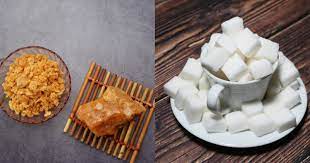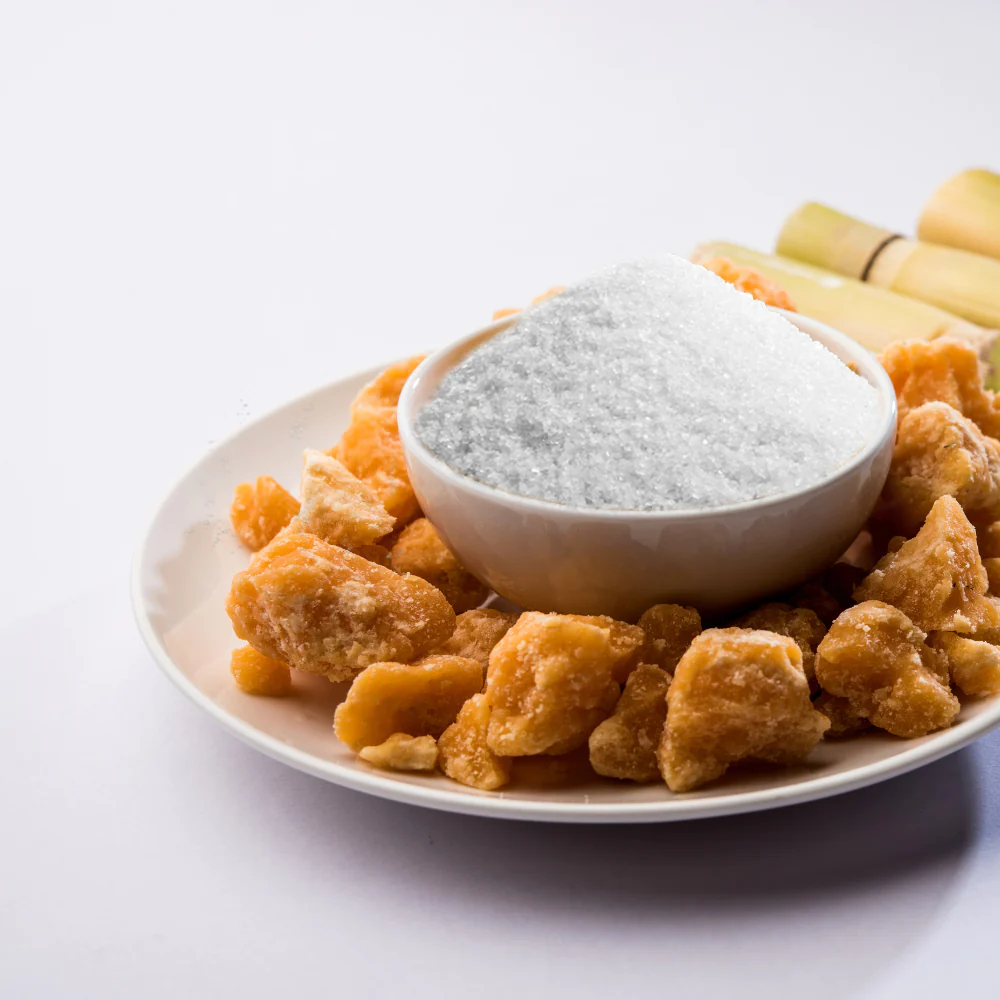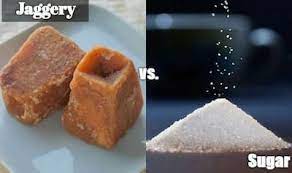Jaggery vs sugar – two sweeteners that are ubiquitous in Indian kitchens. Often used interchangeably, they originate from the same source. Yet jaggery and sugar differ significantly in their production methods and health impacts.
In this blog post, let’s do a close comparison of these two sweeteners. We’ll analyze:
- What is jaggery and sugar?
- Nutritional benefits
- Processing and production
- Environmental impacts
- Culinary uses
- The verdict: which is better?
By the end, you’ll have a clear understanding of whether jaggery or sugar is the right choice for your sweet tooth!
jaggery vs Sugar: What is Jaggery and Sugar?

Both jaggery and sugar originate from sugarcane juice.
Jaggery is sometimes called gur or bellam in different Indian languages. It is made by boiling raw, concentrated sugarcane juice in large shallow pans. The juice is stirred continuously as it reduces to form thick, golden brown jaggery crystals.
In contrast, sugar is commercially produced from sugarcane juice that is purified multiple times via centrifugation and then crystallized. The final product is sparkling white granulated sugar.
While made from the same source material, jaggery and sugar vary greatly in their processing methods and retention of sugarcane’s natural properties. Let’s look closer at their nutrition profiles.
Nutritional Benefits – Jaggery vs. Sugar

| Nutrient | Jaggery | Sugar |
|---|---|---|
| Calories | ~380 kcal per 100g | 387 kcal per 100g |
| Glycemic index | Low (~43) | High (65-80) |
| Minerals | Rich in iron, magnesium, potassium, phosphorus, selenium | Minimal minerals |
| Phytochemicals | Retains some vitamins and phytochemicals like phenols and flavonoids from sugarcane juice | Removed during processing |
This table makes their differences clear. While both provide carbohydrates, jaggery has a lower glycemic index so it raises blood sugar more gradually.
Jaggery retains sugarcane’s minerals and phytochemicals lost when making refined sugar. Compounds like flavonoids act as antioxidants.
So nutrition-wise, jaggery wins – it offers more micronutrients and health benefits than plain sugar. But how do their production methods compare?
Production and Processing

Jaggery production is minimally processed, which is why it retains more nutrients. Sugarcane juice is simply condensed through boiling and then shaped into molds to solidify this unrefined syrup.
Making refined sugar requires heavy industrial processing. Sugarcane juice goes through multiple centrifugation and filtration steps to isolate sucrose crystals. This intensive purification leaves behind only empty calories.
Here’s a simple breakdown of the steps:
Jaggery
- Extract sugarcane juice
- Boil and condense juice in pans
- Cool, mold and dry jaggery blocks
Sugar
- Extract and purify sugarcane juice
- Crystallize sucrose via repeated centrifugation
- Dry and polish refined white sugar
Jaggery production is low-tech, decentralized, and can be done locally on small farms. Sugar production requires costly centralized factories.
So jaggery again scores for its simpler, less processed method requiring virtually no machinery. Now let’s weigh their environmental impacts.
Environmental Impact
As a cottage industry, jaggery has a much smaller carbon footprint. Its production emits negligible greenhouse gases and causes no pollution.
Sugarcane fields absorb carbon dioxide as the plants grow. Jaggery’s emissions mainly come from burning bagasse as fuel for boiling juice. This renewable energy source is carbon-neutral.
Meanwhile, sugar production emits high amounts of greenhouse gases. Modern sugar factories rely on fossil fuels – coal, oil or natural gas. The multiple stages of refining also require substantial electricity and water.
Growing sugarcane as a monocrop for sugar is linked to biodiversity loss, soil degradation and pollution from fertilizers and pesticides.
So for environmental impact, jaggery again clearly wins over commercial white sugar.
Culinary Uses
Jaggery and sugar differ slightly in their culinary roles.
Jaggery has a complex, toasty flavor complementing many savory dishes. It is commonly used in curries, chutneys, rasam and other preparations.
Sugar tastes sweeter, with no undertones. It blends seamlessly into sweets and desserts as the primary sweetener.
For sweetness, both work well in moderation. But jaggery enhances certain savory foods through its rich, caramelized flavor.
So while sugar may be more versatile as a standalone sweetener, jaggery brings more nuance to complex dishes.
The Verdict: Jaggery vs. Sugar

Sweet Jaggery
Looking at all the parameters, a clear winner emerges in this sweet debate.
Jaggery has distinct nutritional, environmental and processing advantages over refined sugar. It retains micronutrients, has a lower glycemic index and minimal environmental impact. Sugar provides only empty calories.
For flavor, jaggery offers complexity while sugar provides pure sweetness. Use jaggery in moderation as a more nutritious alternative, especially for savory recipes. Limit sugar intake.
However, those with diabetes should consult a doctor before consuming either in large amounts. Monitor your glycemic response.
What’s your take, readers? Convince me if you think I’m wrong! Provide counterpoints and let’s have a nuanced discussion on the pros and cons. Whatfurther information could help us reach an objective verdict?
I’m open to changing my position if you raise compelling arguments. Let me know your experiences using jaggery versus sugar. Together we can reach the sweet truth.







